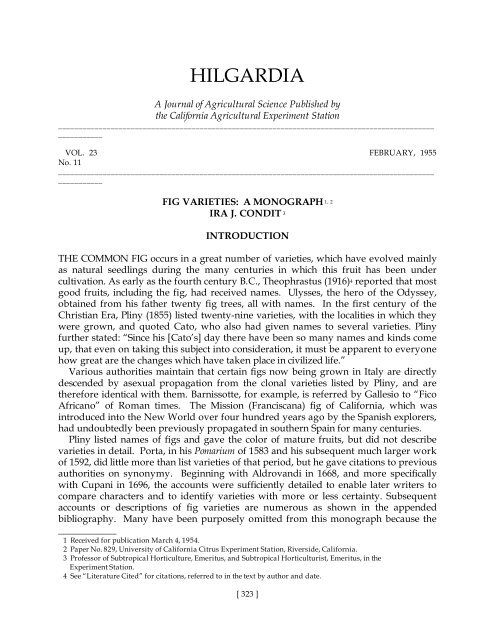Fig Varieties: A Monograph - uri=ucce.ucdavis
Fig Varieties: A Monograph - uri=ucce.ucdavis
Fig Varieties: A Monograph - uri=ucce.ucdavis
You also want an ePaper? Increase the reach of your titles
YUMPU automatically turns print PDFs into web optimized ePapers that Google loves.
HILGARDIA<br />
A Journal of Agricultural Science Published by<br />
the California Agricultural Experiment Station<br />
_____________________________________________________________________________________________<br />
___________<br />
VOL. 23 FEBRUARY, 1955<br />
No. 11<br />
_____________________________________________________________________________________________<br />
___________<br />
FIG VARIETIES: A MONOGRAPH 1, 2<br />
IRA J. CONDIT 3<br />
INTRODUCTION<br />
THE COMMON FIG occurs in a great number of varieties, which have evolved mainly<br />
as natural seedlings during the many centuries in which this fruit has been under<br />
cultivation. As early as the fourth century B.C., Theophrastus (1916) 4 reported that most<br />
good fruits, including the fig, had received names. Ulysses, the hero of the Odyssey,<br />
obtained from his father twenty fig trees, all with names. In the first century of the<br />
Christian Era, Pliny (1855) listed twenty-nine varieties, with the localities in which they<br />
were grown, and quoted Cato, who also had given names to several varieties. Pliny<br />
further stated: “Since his [Cato’s] day there have been so many names and kinds come<br />
up, that even on taking this subject into consideration, it must be apparent to everyone<br />
how great are the changes which have taken place in civilized life.”<br />
Various authorities maintain that certain figs now being grown in Italy are directly<br />
descended by asexual propagation from the clonal varieties listed by Pliny, and are<br />
therefore identical with them. Barnissotte, for example, is referred by Gallesio to “Fico<br />
Africano” of Roman times. The Mission (Franciscana) fig of California, which was<br />
introduced into the New World over four hundred years ago by the Spanish explorers,<br />
had undoubtedly been previously propagated in southern Spain for many centuries.<br />
Pliny listed names of figs and gave the color of mature fruits, but did not describe<br />
varieties in detail. Porta, in his Pomarium of 1583 and his subsequent much larger work<br />
of 1592, did little more than list varieties of that period, but he gave citations to previous<br />
authorities on synonymy. Beginning with Aldrovandi in 1668, and more specifically<br />
with Cupani in 1696, the accounts were sufficiently detailed to enable later writers to<br />
compare characters and to identify varieties with more or less certainty. Subsequent<br />
accounts or descriptions of fig varieties are numerous as shown in the appended<br />
bibliography. Many have been purposely omitted from this monograph because the<br />
____________<br />
1 Received for publication March 4, 1954.<br />
2 Paper No. 829, University of California Citrus Experiment Station, Riverside, California.<br />
3 Professor of Subtropical Horticulture, Emeritus, and Subtropical Horticulturist, Emeritus, in the<br />
Experiment Station.<br />
4 See “Literature Cited” for citations, referred to in the text by author and date.<br />
[ 323 ]
















![Fig Trees in North Carolina [Archive] - IDigMyGarden ... - Figs 4 Fun](https://img.yumpu.com/26905320/1/190x245/fig-trees-in-north-carolina-archive-idigmygarden-figs-4-fun.jpg?quality=85)